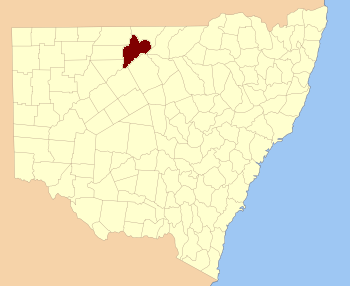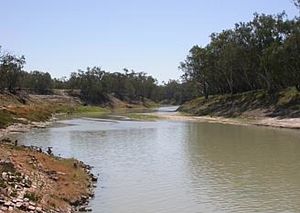Gunderbooka County facts for kids
Quick facts for kids GunderbookaNew South Wales |
|||||||||||||||
|---|---|---|---|---|---|---|---|---|---|---|---|---|---|---|---|

Location in New South Wales
|
|||||||||||||||
|
|||||||||||||||
Gunderbooka County is a special kind of area in New South Wales, Australia. It's one of 141 such areas called cadastral divisions. These divisions are like old-fashioned maps used to describe land for things like property ownership.
Contents
Exploring Gunderbooka County's Location
Gunderbooka County is found in the western part of New South Wales. It has natural borders made by important rivers. The Warrego River forms its western edge. To the southeast, you'll find the Culgoa River and the famous Darling River.
This county stretches down to where the Warrego River meets the Darling River. This meeting point is just north of the town of Bourke. While Bourke itself is just outside the county, a small part called North Bourke is inside. North Bourke is the only real settlement you'll find within Gunderbooka County today. The whole county is managed by the local government, with its main office in Bourke.

The Meaning Behind the Name
The name Gunderbooka comes from a local Aboriginal word. It's also the name of a large property in the area called Gundabook Station. This shows the deep connection the land has to its original inhabitants.
A Journey Through Gunderbooka's Past
The land of Gunderbooka County has a rich history. For thousands of years, it was the traditional home of several Aboriginal tribes.
- The Gunu people lived in the west, along the Warrego River.
- The Barranbidgee people lived in the south, near the floodplains of the Darling River.
- The Wangoibon tribes lived on the opposite bank of the Darling River, in what is now Cowper County.
- Further north in the county lived the Manuwari people.
The first European explorers arrived in the area in the early 1800s. Charles Sturt explored here in 1828. Later, Thomas Mitchell visited in 1835.
Famous Australian poet Henry Lawson walked through this county in 1892. He walked from Bourke to Hungerford, experiencing the vast landscape. Another poet, Oglevy, worked in Engonnia around the time of Federation. He created the well-known phrase "Back of Burke" to describe how remote and far away the northern part of the county felt.
Images for kids


